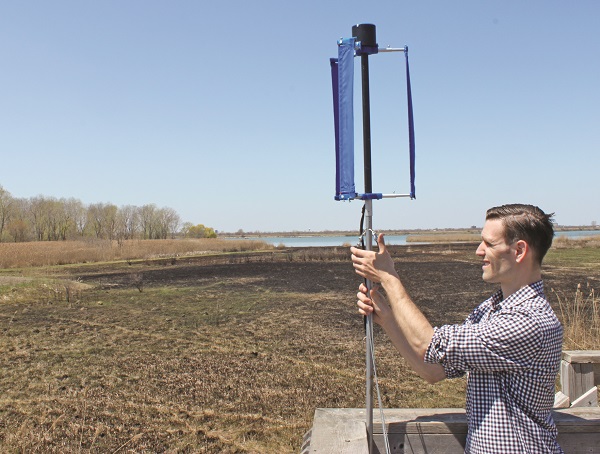General News » News
Aurora native takes “radical” approach to electrifying developing world
May 20, 2015 · 0 Comments

By Brock Weir
They say that if you build it, they will come – and Aurora native Kyle Bassett found that to be true when he and his team erected a wind turbine on the beach of a Nicaraguan village in 2010.
At 20 feet tall and 15 feet wide, it became a landmark that was hard to miss in the isolated community and, sure enough, it captured the attention of locals.
“One fantastic image I have in my mind is a boy riding his horse towards the wind turbine, looking at me and saying, ‘I hear you can charge cell phones here,’” Mr. Bassett recalls. “I said, ‘Absolutely, what do you have?’ and he pulled out a bag of all the cell phones they had in the next village over. When I saw that, it was powerful and a really good indication that word was spreading and people wanted to utilize it.”
Mr. Bassett’s journey with his wind turbine system started in 2010 with a visit to the Central American nation to develop low cost wind turbines for remote communities, often areas which have never before had electricity. The goal, he says, was to create a community charging station powered almost completely by wind turbines – with an assist from some solar panels.
“The station [we chose] was a location where people from the Region could bring their cell phones or flashlights to be charged for free,” he explains. “The community response was overwhelming. We had over 1,500 charges in the first two years of the charging centre. From this project, we basically learned firsthand how a tiny amount of electricity can make a huge difference in people’s lives.”
From those early days, the once 20-foot-tall turbine has gone through many iterations. As the project has been honed, the turbine has been whittled down to just half a metre tall. At the smaller scale, it provides enough energy for the way people would use it in remote communities and, most importantly, allows his company to manufacture components by 3D printing technology and share this knowledge with the world.
“The nice thing about 3D printing is it allows it to be a very streamlined way for the design to be communicated and shared around the world,” says the Cardinal Carter graduate, who is now sitting his PhD at the University of Windsor. “When you look at other traditional manufacturing techniques like molds, dies, that all requires extensive fixturing and a lot of investments in the upfront overhead costs. 3D printing really eliminates the requirement for all that. A person at home could potentially produce the same quality of printed part we’re producing in our factory and it is a great way to unify the design.”
The idea recently garnered Mr. Bassett a $25,000 prize, winning the David McFadden Energy Entrepreneur Challenge, and he’s hoping it catches on with a wider audience as well, launching a Kickstarter campaign on Friday to keep the momentum going, raising money for a rural deployment initiative once again in Nicaragua.
This project will focus on demonstrating a new model for distributed manufacturing and “rural electrification” using 3D printing. It aims to take 3D printers to produce wind turbines on site where the demand is highest, a “radical approach to reduce the deployment costs of rural electrification technology,” he says.
“I felt relatively confident it would pick up eventually, but certainly not at the rate it did,” says Mr. Bassett of his success in Nicaragua. “I thought it would take some time for people to become accustomed to it, but despite living in rural areas they are still exposed to certain technologies. They are not in any way ignorant of technology, they just haven’t had [a practical use for it]. Once they saw this opportunity, they really jumped on it. Families even began to save money so they could purchase a basic flashlight so their son or daughter could read at night, or a basic cell phone so a father who was a fisherman could communicate back to the family that he was safe on a fishing expedition.
“In Canada alone, there are almost 104,000 people who live in off grid rural communities. Only about 15 per cent of those communities utilize renewable energy resources. One of the local community partners we have been working with in North West Territories sent it to a schoolteacher in this community, so he is working with his students and giving us feedback which has been so fantastic. They have opened our eyes to new applications we hadn’t really thought of. This has been a great collaboration that has really helped improve the project and improve the turbines.”
For more information on the Kickstarter campaign, visit www.kickstarter.com/projects/rmrdtech/a-small-wind-turbine-for-a-big-difference.











